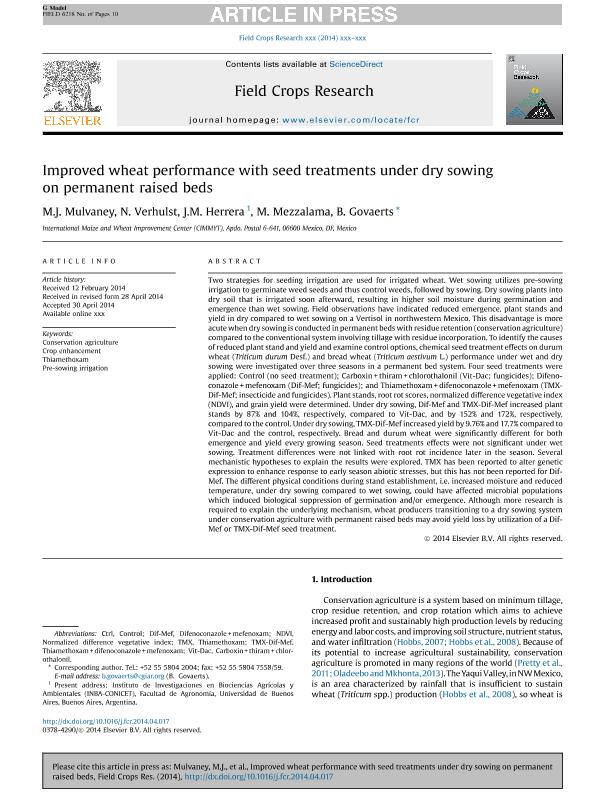Mostrar el registro sencillo del ítem
dc.contributor.author
Mulvaney, M.J.
dc.contributor.author
Verhulst, N.
dc.contributor.author
Herrera, Juan Manuel

dc.contributor.author
Mezzalama, M.
dc.contributor.author
Govaerts, B.
dc.date.available
2019-09-25T19:16:46Z
dc.date.issued
2014-08
dc.identifier.citation
Mulvaney, M.J.; Verhulst, N.; Herrera, Juan Manuel; Mezzalama, M.; Govaerts, B.; Improved wheat performance with seed treatments under dry sowing on permanent raised beds; Elsevier Science; Field Crops Research; 164; 1; 8-2014; 189-198
dc.identifier.issn
0378-4290
dc.identifier.uri
http://hdl.handle.net/11336/84448
dc.description.abstract
Two strategies for seeding irrigation are used for irrigated wheat. Wet sowing utilizes pre-sowing irrigation to germinate weed seeds and thus control weeds, followed by sowing. Dry sowing plants into dry soil that is irrigated soon afterward, resulting in higher soil moisture during germination and emergence than wet sowing. Field observations have indicated reduced emergence, plant stands and yield in dry compared to wet sowing on a Vertisol in northwestern Mexico. This disadvantage is more acute when dry sowing is conducted in permanent beds with residue retention (conservation agriculture) compared to the conventional system involving tillage with residue incorporation. To identify the causes of reduced plant stand and yield and examine control options, chemical seed treatment effects on durum wheat (Triticum durum Desf.) and bread wheat (. Triticum aestivum L.) performance under wet and dry sowing were investigated over three seasons in a permanent bed system. Four seed treatments were applied: Control (no seed treatment); Carboxin. +. thiram. +. chlorothalonil (Vit-Dac; fungicides); Difenoconazole. +. mefenoxam (Dif-Mef; fungicides); and Thiamethoxam. +. difenoconazole. +. mefenoxam (TMX-Dif-Mef; insecticide and fungicides). Plant stands, root rot scores, normalized difference vegetative index (NDVI), and grain yield were determined. Under dry sowing, Dif-Mef and TMX-Dif-Mef increased plant stands by 87% and 104%, respectively, compared to Vit-Dac, and by 152% and 172%, respectively, compared to the control. Under dry sowing, TMX-Dif-Mef increased yield by 9.76% and 17.7% compared to Vit-Dac and the control, respectively. Bread and durum wheat were significantly different for both emergence and yield every growing season. Seed treatments effects were not significant under wet sowing. Treatment differences were not linked with root rot incidence later in the season. Several mechanistic hypotheses to explain the results were explored. TMX has been reported to alter genetic expression to enhance response to early season abiotic stresses, but this has not been reported for Dif-Mef. The different physical conditions during stand establishment, i.e. increased moisture and reduced temperature, under dry sowing compared to wet sowing, could have affected microbial populations which induced biological suppression of germination and/or emergence. Although more research is required to explain the underlying mechanism, wheat producers transitioning to a dry sowing system under conservation agriculture with permanent raised beds may avoid yield loss by utilization of a Dif-Mef or TMX-Dif-Mef seed treatment.
dc.format
application/pdf
dc.language.iso
eng
dc.publisher
Elsevier Science

dc.rights
info:eu-repo/semantics/openAccess
dc.rights.uri
https://creativecommons.org/licenses/by-nc-nd/2.5/ar/
dc.subject
CONSERVATION AGRICULTURE
dc.subject
CROP ENHANCEMENT
dc.subject
PRE-SOWING IRRIGATION
dc.subject
THIAMETHOXAM
dc.subject.classification
Agronomía, reproducción y protección de plantas

dc.subject.classification
Agricultura, Silvicultura y Pesca

dc.subject.classification
CIENCIAS AGRÍCOLAS

dc.title
Improved wheat performance with seed treatments under dry sowing on permanent raised beds
dc.type
info:eu-repo/semantics/article
dc.type
info:ar-repo/semantics/artículo
dc.type
info:eu-repo/semantics/publishedVersion
dc.date.updated
2019-09-24T12:52:26Z
dc.journal.volume
164
dc.journal.number
1
dc.journal.pagination
189-198
dc.journal.pais
Países Bajos

dc.journal.ciudad
Amsterdam
dc.description.fil
Fil: Mulvaney, M.J.. Centro Internacional de Mejoramiento de Maiz y Trigo; México
dc.description.fil
Fil: Verhulst, N.. Centro Internacional de Mejoramiento de Maiz y Trigo; México
dc.description.fil
Fil: Herrera, Juan Manuel. Consejo Nacional de Investigaciones Científicas y Técnicas. Oficina de Coordinación Administrativa Parque Centenario. Instituto de Investigaciones en Biociencias Agrícolas y Ambientales. Universidad de Buenos Aires. Facultad de Agronomía. Instituto de Investigaciones en Biociencias Agrícolas y Ambientales; Argentina. Centro Internacional de Mejoramiento de Maiz y Trigo; México
dc.description.fil
Fil: Mezzalama, M.. Centro Internacional de Mejoramiento de Maiz y Trigo; México
dc.description.fil
Fil: Govaerts, B.. Centro Internacional de Mejoramiento de Maiz y Trigo; México
dc.journal.title
Field Crops Research

dc.relation.alternativeid
info:eu-repo/semantics/altIdentifier/doi/http://dx.doi.org/10.1016/j.fcr.2014.04.017
dc.relation.alternativeid
info:eu-repo/semantics/altIdentifier/url/https://www.sciencedirect.com/science/article/pii/S037842901400118X
Archivos asociados
